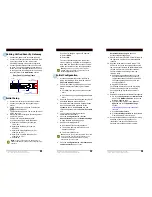
TD 92326GB
2009-03-10 / Ver. E
Installation and Operation Manual
VoIP Gateway
132
19
Considerations on the Configuration of the Gatekeeper Interfaces
The telephony infrastructure in the VoIP environment always consists of three different
modules: VoIP end points, VoIP Gateways and Gatekeeper.
• VoIP end points
These are devices that implement the end points of telephone calls, for example the i75
VoWiFi handsets.
• VoIP Gateways
These are gateways to other telephony networks or technologies. These can be gateways
to the ISDN network or to the analogue telephone network, but also adapters to connect
traditional, analogue terminals or existing PBXs. Gateways make it possible to reach users
or terminals outside of your local VoIP network.
• Gatekeeper
Gatekeepers are used for call control and call switching. Gatekeepers can manage VoIP
terminals and gateways, interpret call numbers and names and thus switch calls. They
adopt the role of the PBXs or the exchange in traditional telephony.
Gatekeepers and VoIP end points, or VoIP Gateways, usually communicate via the RAS
protocol. The VoIP Gateway can be used with or without RAS (Registration, Admission and
Status) protocol. As far as the telephony features are concerned, no disadvantages result
from operating without RAS. Even the sophisticated routing functions of your VoIP
Gateway can be fully used in this operating mode.
Using the RAS protocol though, offers a number of advantages:
• The gatekeeper is able to convert logical device names into IP addresses. This allows
VoIP devices with dynamic IP addresses to be integrated. Only in this way can VoIP
devices be used which have been configured via DHCP.
• The gatekeeper is able to continuously keep a record of the availability of the VoIP
devices known to it. This allows the administrator to have an overview of the status at
any time. Furthermore, the switching of calls can be made dependent on availability,
without having to make this time-consuming check at the time of the call. This results
in a considerable improvement in dealing with errors.
• For many third party VoIP devices, the RAS protocol is mandatory. We recommend
putting the VoIP Gateway's gatekeeper into operation and, if possible, using the RAS
protocol. Individual VoIP devices with which the VoIP Gateway is supposed to
communicate which do not allow the RAS protocol can still be addressed directly
without any difficulty.
You can also operate the VoIP Gateways in conjunction with a gatekeeper which is already
available.
Note however, that a number of features in a VoIP network also depend on the
gatekeeper in use. The specific features available when operating with an external
gatekeeper therefore vary depending on the individual case.
















































